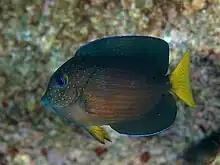Ctenochaetus binotatus
Ctenochaetus binotatus, the twospot bristletooth or twospot surgeonfish, is a species of marine ray-finned fish belonging to the family Acanthuridae, the surgeonfishes unicornfishes and tangs. This species has a wide Indo-Pacific distribution.
| Ctenochaetus binotatus | |
|---|---|
 | |
| Scientific classification | |
| Domain: | Eukaryota |
| Kingdom: | Animalia |
| Phylum: | Chordata |
| Class: | Actinopterygii |
| Order: | Acanthuriformes |
| Family: | Acanthuridae |
| Genus: | Ctenochaetus |
| Species: | C. binotatus |
| Binomial name | |
| Ctenochaetus binotatus J. E. Randall, 1955 | |
| Synonyms[2] | |
| |
Taxonomy
Ctenochaetus binotatus was first formally described in 1955 by the American ichthyologist John Ernest Randall with its type locality given as Batangas Bay, off the island of Luzon, in the Philippines.[3] The genera Ctenochaetus and Acanthurus make up the tribe Acanthurini, which is one of three tribes in the subfamily Acanthurinae, which is one of the two subfamilies in the family Acanthuridae.[4]
Etymology
The specific name of this species, binotatus, meaning "twice marked", is a reference to the two black spots present on the flanks, one at the axil of the soft-rayed part of the dorsal fin and the other at the rear of the anal fin.[5]
Description
Ctenochaetus binotatus has a dorsal fin which is supported by 8 spines and between 24 and 27 soft rays; for the anal fin the figures are 3 and between 22 and 25 respectively.[2] The depth of the body is more than half of its standard length. In adults, the caudal fin is lunate.[6] The overall colour is brown, but the head and chest are marked with pale spots, and there are pale lines horizontal lines along the flanks. The eyes are blue, and there is an obvious dark spot at the rear axils of both the dorsal and anal fins.[7] This species has a maximum published total length of 22 cm (8.7 in).[2]
Distribution and habitat
Ctenochaetus binotatus has a wide Indo-Pacific distribution. It can be found across the Indian Ocean, from the eastern African coast between Kenya and Sodwana Bay in South Africa [6] all the way to the Andaman Sea, although it is absent off some Asian coasts. In the Pacific Ocean, it can be found as far east as the Tuamotu Islands and Mangareva, and everywhere between southern Japan and New South Wales.[1] It is found at depths of 60 m (200 ft) in areas of coral and rubble, deep lagoons and seaward reefs.[2]
Biology
Ctenochaetus binotatus is typically found singly. These fishes feed by scooping up the film of detritus and single-celled algae, such as the dinoflagellate Gambierdiscus toxicus, which is a producer of the ciguatera toxin. This species is a link in the ciguatera chain.[2]
Utilisation
Ctenochaetus binotatus is traded in the aquarium industry. It is also used as a food fish in some areas, e.g. Thailand.[1]
References
- Clements, K.D.; Choat, J.H.; Abesamis, R.; et al. (2012). "Ctenochaetus binotatus". IUCN Red List of Threatened Species. 2012: e.T177955A1501829. doi:10.2305/IUCN.UK.2012.RLTS.T177955A1501829.en. Retrieved 19 November 2021.
- Froese, Rainer; Pauly, Daniel (eds.) (2023). "Ctenochaetus binotatus" in FishBase. June 2023 version.
- Eschmeyer, William N.; Fricke, Ron & van der Laan, Richard (eds.). "Species in the genus Ctenochaetus". Catalog of Fishes. California Academy of Sciences. Retrieved 4 October 2023.
- J. S. Nelson; T. C. Grande; M. V. H. Wilson (2016). Fishes of the World (5th ed.). Wiley. pp. 497–502. ISBN 978-1-118-34233-6.
- Christopher Scharpf & Kenneth J. Lazara, eds. (12 January 2021). "Order ACANTHURIFORMES (part 2): Families EPHIPPIDAE, LEIOGNATHIDAE, SCATOPHAGIDAE, ANTIGONIIDAE, SIGANIDAE, CAPROIDAE, LUVARIDAE, ZANCLIDAE and ACANTHURIDAE". The ETYFish Project Fish Name Etymology Database. Christopher Scharpf and Kenneth J. Lazara. Retrieved 4 October 2023.
- John E. Randall (2022). "Family Acanthuridae". In Phillip C Heemstra; Elaine Heemstra; David A Ebert; Wouter Holleman; John E Randall (eds.). Coastal Fishes of the Western Indian Ocean (PDF). Vol. 5. South African Institute for Aquatic Biodiversity. pp. 219–244. ISBN 978-1-990951-32-9. Archived (PDF) from the original on 2023-06-12. Retrieved 2023-07-17.
- Bray, D.J. (2018). "Ctenochaetus binotatus". Fishes of Australia. Museums Victoria. Retrieved 4 October 2023.
External links
- http://www.marinespecies.org/aphia.php?p=taxdetails&id=219655
- Photos of Ctenochaetus binotatus on Sealife Collection
